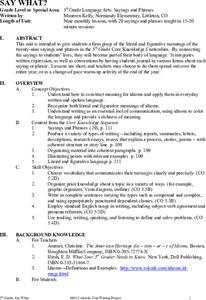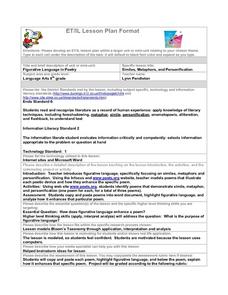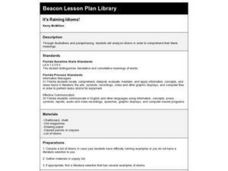Houghton Mifflin Harcourt
Grade 4 Reading Item Specifications
Is it the end of the school year and you're in need of test practice? Use a set of reading passages to challenge fourth graders to answer questions based on what they read. Some of the questions require readers to compare and contrast a...
EngageNY
Analyzing Word Choice: Atticus’s Closing Speech (Chapters 20-21)
Choose your words carefully. Scholars begin by reading a line of Atticus's closing speech in To Kill A Mockingbird. Readers work independently on their note catchers, then complete a Think-Pair-Share activity with partners. They finish...
Shmoop
ELA.CCSS.ELA-Literacy.L.11-12.5
"Timid, scared, terrified." High school scholars examine words, their denotations and connotations, in a series of exercises that use lines from Shakespeare to explore figurative language and word relationships. Participants then...
Curated OER
Similes
A simile is a non literal phrase that needs to be deciphered for contextual meaning. Similes are also fun to read and write. Third graders get cozy with similes found in the book If You Hopped Like a Frog by David M. Schwartz. They use...
Curated OER
The Story of Us: Mud Woman Rolls On
Young writers will literally step into art and creative writing as they become the figures featured in the sculpture Mud Woman Rolls On. Begin by showing your class a picture of the sculpture and having a discussion about its most...
National Endowment for the Humanities
Hopi Poetry
The Hopi refer to corn as their children, demonstrating its importance to the Native American group. Class members consider the role of literal and figurative language by examining poetry from this indigenous group. The resource includes...
Curated OER
Poems in Sections: The Mosaic Format
Students explore poetry. They examine metaphors. Students discuss and write examples of "figurative" and "literal" language. They read mosaic poetry. Students write a poem in mosaic format.
Curated OER
It's Raining Cats and Dog: Studying Idioms
Seventh graders determine the literal and figurative meanings of idioms and research the history of idioms. In this idioms lesson plan, 7th graders read two books by Fred Gwynne and select two idioms from the texts to research. Students...
Curated OER
In a Pickle
Fifth graders listen to a story that uses homonyms and figurative language throughout the text. They illustrate the literal and figurative meanings of some figures of speech.
Curated OER
Say What?
Students explore the literal and figurative meanings of twenty-nine phrases and sayings. This unit of nine lessons integrates written expression and convention to demonstrate the value of idioms to the language.
Curated OER
Understanding Idioms
Students explore figurative language. In this idioms lesson, students research the origin of instructor-selected idioms. Students literally interpret the idioms. Interpretations are photographed and then presented to the class.
Curated OER
Similes, Metaphors, and Personification
Eighth graders explore figurative language, specifically focusing on similes, metaphors and personification. They work on the web to identify poems that demonstrate simile, metaphor, and personification, then analyze how it enhances...
Curated OER
Heavens to Betsy There Sure are a Lot of Sayings!!
Students explore a variety of sayings and phrases used in the English language in the seventeen lessons of this unit. Through visual, auditory, and kinestic activities, students are immersed in the study of the English language.
Curated OER
It's Raining Idioms!
Sixth graders analyze idioms and find examples from literature. They choose one idiom and finds pictures or draws pictures to show what it would mean if taken literally and what is it generally thought to mean.
Curated OER
Similes, Metaphors, and Symbols
Here is an outline of a lesson in which learners examine the use of similes, metaphors, and symbols in poetry. They define similes, metaphors, and symbols, complete a handout, and create a poem using types of figurative language.
Curated OER
Literary Techniques
Need to review literary terms/techniques with your class? The slides in this presentation define and give examples of 22 common literary terms. The PowerPoint could be used for AP test prep.
Curated OER
Visual Puns - Paper Mache Sculpture
Explore the pop art movement and create a sculpture in the pop art style based on a visual pun, or play on words. The scholar's work may use humor, allegory, metaphor, or be in the form of a parody. Visual examples are provided, and some...
Curated OER
Idiom
In this idioms worksheet, students write meanings of the idioms provided to them. Students complete 20 idiom meanings on this worksheet.
Curated OER
Idioms
In this idiom activity, students study 23 English idioms. Students match each given idiom with its literal definition and meaning.
Curated OER
Headless Horseman, Heady Author
Twelfth graders explore figurative language as it appears in Washington Irving's original text, The Legend of Sleepy Hollow, answer questions based on story, and write sequels to it by using the different types of figurative language...
Curated OER
Blanket the Plains
Students discuss vivid imagery in a story. In this figurative language lesson, students read samples of sensory language and then discuss the meaning of a piece of figurative language. Students provide examples.
Curated OER
Elements of Fables
Students explore the attributes of fables. In this literature lesson, students read several fables and identify the moral lesson, characterization, and figurative language in each. Students then retell their favorite fables in their own...
EngageNY
Building Background Knowledge: Learning About the Historical and Geographical Setting of Esperanza Rising (Chapter 1: “Aguascalientes, Mexico, 1924”)
Set up your class to read Esperanza Rising, by Pam Muñoz Ryan, through a class read-aloud and exploration of the setting. The detailed instructional activity outlines each step. First, class members read over the first few pages and...
Curated OER
The World of Idioms (1)
In this idioms online worksheet, students use drop down menus add the correct word to 10 idioms. They submit their answers using the "Done" button.

























